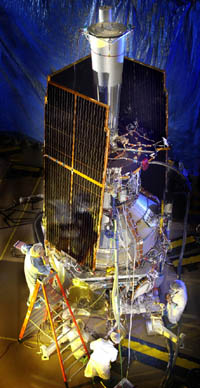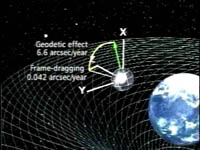Imagine the Universe News - 19 April 2004
World's Most Precise Gyroscopes Ready To Test Einstein Theory
| 20 April 2004 |

|
|
The completed space vehicle during solar array installation.
(Image credit to Russ Underwood, Lockheed Martin Corporation) |
Gravity Probe-B, NASA's spacecraft designed to test two important predictions of Albert Einstein's general theory of relativity, was successfully launched from Vandenberg Air Force Base, Calif., at 12:57 p.m. EDT, April 20, 2004.
NASA's Gravity Probe B mission, also known as GP-B, will use four ultra-precise gyroscopes, orbiting the Earth in a unique satellite, to experimentally test two extraordinary predictions of Einstein's 1916 theory that space and time are distorted by the presence of massive objects. The two effects being tested are: The geodetic effect, the amount by which the Earth warps local spacetime in which it resides, and the frame-dragging effect, the amount by which the Earth drags local spacetime around with it as it rotates.
"Gravity Probe-B has the potential to uncover fundamental properties of the invisible universe, a universe which seems very bizarre and alien to our everyday perceptions yet one that Einstein tried to show us almost a century ago," said Dr. Anne Kinney, director of the Astronomy and Physics Division in NASA's Office of Space Science, Washington. "Testing the key aspects of Einstein's theory, such as GP-B will do, will provide crucial information to science just as it has already helped America by pushing technological progress in developing the tools needed for these ultra- precise measurements," she added

|
|
Artist concept depicting Gravity Probe B's
measurement of the geodetic effect (in the x-z plane) and of
the frame dragging effect (in the y-z plane).
(Credit: York University/Dr. Norbert Bartel) |
Once placed in its polar orbit of 640 kilometers (400 miles) above Earth, GP-B will circle the globe every 97.5 minutes, crossing over both poles. In-orbit checkout and calibration is scheduled to last 40-60 days, followed by a 13-month science-data acquisition period and a two-month post-science period for calibrations.
To test the general theory of relativity, GP-B will monitor any drift in the gyroscopes' spin axis alignment in relation to its guide star, IM Pegasi (HR 8703). Over the course of a year, the anticipated spin axis drift for the geodetic effect is a angle of 6.6144 arcseconds, and the anticipated spin axis drift for the frame-dragging effect is even smaller, only 40.9 milliarcseconds. To illustrate the size of the angles, if you climbed a slope of 40.9 milliarcseconds for 100 miles, you would rise only one inch in altitude.
During the mission, data from GP-B will be received a minimum of two times each day. Earth-based ground stations or NASA's data relay satellites can receive the information. Controllers will be able to communicate with GP-B from the Mission Operations Center at Stanford University.
Data will include space vehicle and instrument performance, as well as the very precise measurements of the gyroscopes' spin-axis orientation. By 2005 the GP-B mission will be complete, and a one-year period is planned for scientific analysis of the data.
"Developing GP-B has been a supreme challenge requiring the skillful integration of an extraordinary range of new technologies," said Professor Francis Everitt of Stanford University, and the GP-B principal investigator. "It is hard to see how it could have been done without the kind of unique long-term collaboration that we have had between Stanford, Lockheed Martin, and NASA," he said. In 1962, Dr. Everitt joined the team at Stanford that conceived the idea for GP-B. He has been working on it ever since.

